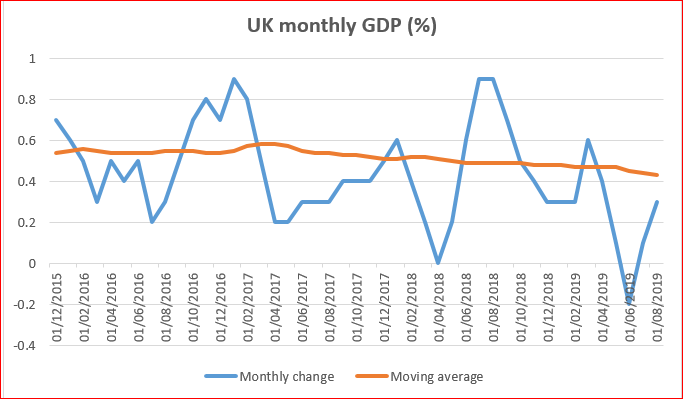It is perhaps fitting that, with the UK as split as ever over membership of the European Union (EU), the latest agreed Brexit extension runs to the end of January, thought by many (perhaps wrongly) to be named after the two-faced Roman god Janus, often referred to as the “god of beginnings, gates, transitions, time, duality, doorways, passages and endings”.
Now that the EU has extended the Brexit deadline by up to three months to 31 January 2020, and a highly unpredictable UK general election is slated for 12 December this year, one thing we can be reasonably sure of is that there is still no certainty of light at the end of the tunnel any time soon for the UK economy.
UK gross domestic product (GDP) has displayed a sawtooth pattern of ups and downs since the country’s 2016 referendum on leaving the EU, but has certainly been losing momentum as investment has waned, as shown by the orange line in the chart below, which represents the 36-month moving average.

Source: Bloomberg, September 2019
While there was a notable pickup in GDP in the run-up to the originally proposed 29 March 2019 EU exit date owing to stockpiling, GDP then tanked once the leave date was extended. The more recent pickup this quarter, ahead of the now defunct Halloween exit deadline, seems less dramatic, and yet retailers (and probably others) are holding record stock. Those high stock levels don’t bode well for growth over the fourth quarter, and while employment and real incomes look relatively strong, consumer confidence remains weak.
Narrow runway to success
A general election is viewed by many, not least UK Prime Minister Boris Johnson and his cabinet, as the only way to break the Brexit-related impasse, but in our view there is only a narrow runway that would lead to Boris Johnson successfully implementing his Brexit deal. Below are a range of potential scenarios that could arise from the December election.
- Johnson wins a small but workable majority. This is in no way guaranteed owing to the fractured nature of UK politics and the broad scope for tactical voting; there are a number of rebel Members of Parliament (MPs) and Brexit Party candidates who could split the Conservative Party vote (not to mention the potential for political gaffes from the prime minister himself). In any case, this outcome would simply mean agreeing to an EU ‘divorce’, and not the future trading relationship. It certainly would not guarantee a close trading relationship with the EU any time soon.
- If the Conservatives win a larger majority, the hard-line European Research Group of MPs may feel emboldened to push for a ‘harder’ Brexit, which would at the very least diminish the chances of a close trading relationship with the EU at the end of the transition period.
- The Conservatives become the largest party, but without an overall majority, meaning they would be unable to form a government, having badly let down their only potential ally, the Democratic Unionist Party (DUP).
- The Labour Party forms a coalition or ‘confidence and supply’ government as the largest or second-largest party. This could well lead to a second Scottish independence referendum, and would still provide no immediate clarity on either Brexit or economic policy, adding further uncertainty.
- Neither main party is able to form a government. This is a distinct possibility given the potential for the DUP to once again play the role of ‘kingmaker’. With Johnson being accused of ‘betraying’ the Union, and the prevailing view in some quarters that Labour leader Jeremy Corbyn is an ‘Irish nationalist sympathiser’, there is no guarantee that the DUP would offer its support to either party.
- An outright Corbyn victory. Although this currently seems unlikely, it has the potential to introduce a whole new dynamic – and further volatility.
Market implications
If the election leads to Boris Johnson’s Brexit deal passing, we believe that sterling could easily revisit €1.20 against the euro. Should the election result make Brexit look less likely, sterling could move even higher, and 10-year gilt yields could move to over 1.0%.
Coincidentally, €1.20 is the level to which sterling fell immediately after the 2016 referendum. At that level, it reflects the reality of Brexit, but with a ‘deal of sorts’, whereas back in 2016, it was only a probability. Meanwhile, sterling has traded lower when there have been fears of a ‘no-deal’ Brexit, and because the UK has lost its relative performance lead over the EU.
It remains uncertain whether Boris Johnson’s Brexit deal – and with it a commitment to a close future trading relationship with the EU – will be approved. This therefore points to avoiding a long sterling position. In the meantime, the UK economy continues to become more ‘zombie’-like, which should offer support for gilts for now. Our view is that it is prudent to tactically reduce gilt underweights, while staying neutral on sterling, as the UK economy will effectively remain in a state of limbo until there is a clear break from the status quo one way or the other.
Time will tell if we are closer to the end of the Brexit saga, or if, rather like the two-faced Roman god, opposing views will continue to thwart a resolution.
This is a financial promotion. These opinions should not be construed as investment or other advice and are subject to change. This material is for information purposes only. This material is for professional investors only. Any reference to a specific security, country or sector should not be construed as a recommendation to buy or sell investments in those countries or sectors. Please note that holdings and positioning are subject to change without notice.






Comments